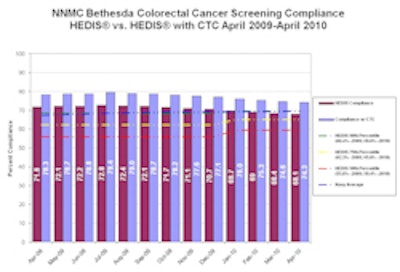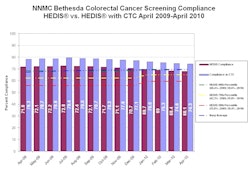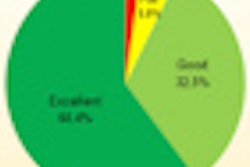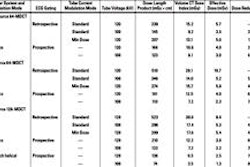
Offering virtual colonoscopy as an option for colorectal cancer screening significantly boosted patient compliance in programs operated by U.S. naval medical centers, according to a study presented at last week's Digestive Disease Week (DDW) meeting in Chicago.
Importantly, the availability of virtual colonoscopy (also known as CT colonography or CTC) at National Naval Medical Center (NNMC) facilities in Bethesda, MD, and San Diego nudged those sites into compliance with criteria set by the Healthcare Effectiveness Data and Information Set (HEDIS), the researchers said. Most healthcare payors and the government use HEDIS, developed by the National Committee for Quality Assurance (NCQA), to measure key healthcare benchmarks.
CTC isn't currently included as one of the HEDIS criteria for colorectal cancer screening tests -- which include every other major screening test, from fecal occult blood testing (FOBT) to conventional optical colonoscopy.
As a result, institutions providing CTC as a colorectal cancer screening test may underestimate HEDIS colon screening compliance, according to the researchers.
The results "demonstrate the power of CTC to get more patients off the sidelines and get them screened," said Dr. Brooks Cash, chief of gastroenterology at the Bethesda, MD-based NNMC in an interview with AuntMinnie.com.
The research team, by Dr. Lindsay Jones, along with Cash and Kathryn Stamps, calculated the increase by adding the CTC screening numbers to overall HEDIS totals. To do so, the researchers retrospectively obtained data by looking up procedure codes on all patients 50 years and older who underwent screening in 2009 or 2010 at the NNMC in Bethesda and the NNMC in San Diego.
They then cross-referenced the data with monthly updates of action reports, including demographics, type, and date of last screening.
During the study period, 1,449 enrollees at NNMC underwent CT colonography. At NNMC, screening totals were below the HEDIS 90th percentile (69.6%) during the months of February (69%), March (68.4%), and April 2010 (68.1%).
However, when they included patients who had undergone only screening CTC, screening compliance rose from between 6.2% and 6.3% during the same months of February (75.3%), March (74.6%), and April (74.3%), Cash said.
"In 2009 and 2010, we were able to show that by including CTC it would allow us to exceed HEDIS by significant amounts," he said. Since the study period, the numbers have continued to grow, peaking at well over 80%, according to Cash.
While it's difficult to translate the HEDIS results into traditional measures of compliance that are based on the percentage of eligible populations screened, they mean roughly that 80% or more of the 69.9% HEDIS 90th percentile population patients are choosing to be screened for CRC -- and in total numbers that range from 6.2 to 6.3 percentage points higher than the numbers of patients screened for colorectal cancer without virtual colonoscopy, Cash said.
When combined with other available data, it's also clear that facilities with a fully integrated CTC screening program -- including same-day colonoscopy for patients who need it -- perform more colorectal cancer screening overall than other naval hospitals, where CTC is offered only on a very limited basis, such as after failed colonoscopy or when obstructing lesions do not permit the colonoscope to reach the cecum.
"The only way to increase HEDIS compliance is by including patients who have any other form of screening for the time period of those tests," Cash said. "I think this demonstrates the power of CTC to get more people screened."
 |
| Click here to enlarge this image. |
| Results from the National Naval Medical Center in Bethesda and San Diego show that overall screening increases significantly to meet HEDIS guidelines when screening CTC is included. |
One study limitation is that patients counted as not screened at the facilities could have gone elsewhere for it, though this scenario is unlikely because the study facilities do not charge the patient for care, he said.
Also, "it would be nice to have clinical outcomes data and know how many cancers we found and how many we prevented -- but we're very happy," he said. Since the CTC program began, not only has overall colorectal cancer screening increased, the use of conventional colonoscopy has grown as well, particularly therapeutic colonoscopy.
Those results are emphasized not only "to assuage the gastroenterologists, but also to encourage the radiologists and primary care docs that [CTC screening] is a very viable option," Cash said. Virtual colonoscopy "has increased our overall screening presentation and become a close second to colonoscopy in terms of screening modalities."
Finally, CTC screening needs to be included in the HEDIS criteria, Cash said. Otherwise, sites that perform CTC screening can be penalized for noncompliance.




















